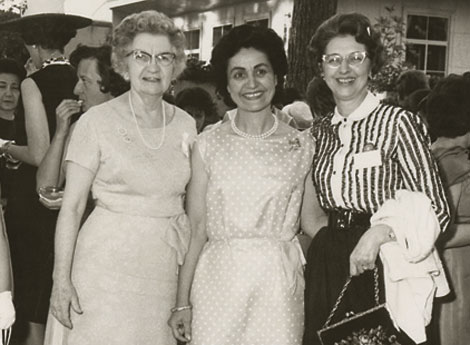Belle Spafford at an International Council of Women convention
When I read
Chapter 6 of Daughters in My Kingdom, I quite enjoyed the story about Belle Spafford and the National Council of Women. According to
DIMK, after being involved in the organization for some time, she (and the other Church ladies) weren't getting anything out of it anymore and wanted to discontinue their association.
Today I was reading chapter 24 of the
George Albert Smith book, which gave another little detail about the situation. Apparently certain "members of the council had been antagonistic toward the Church and had embarrassed Latter-day Saint delegates at its meetings" (GAS, 257). Wow! I love learning about when there's more to the story!
So, if you put the two sources together, this is the story you get (highlighted text is from GAS, other text is from DIMK):
Sister Spafford learned a great lesson from President George Albert Smith about sharing the Church’s values with the women of the world. Soon after she was sustained as Relief Society general president, “a letter came from the National Council of Women, announcing their annual meeting to be held in New York City.
“Sister Spafford had attended those meetings before, and in view of her previous experience, she and her counselors carefully considered the invitation for several weeks.
“They decided to recommend to the President of the Church that the Relief Society terminate its membership in those councils. They prepared a statement of recommendation, listing all of the reasons for so doing.
Sister Belle S. Spafford, general president of the Relief Society, shared an experience in which President Smith taught her this principle. Shortly after being called to her position, Sister Spafford was notified of a meeting to be held in New York City by the National Council of Women. The Relief Society had been a member of that council for many years, but recently several other members of the council had been antagonistic toward the Church and had embarrassed Latter-day Saint delegates at its meetings. Because of this, Sister Spafford and her counselors felt that the Relief Society should terminate its membership in the council, and they drafted a recommendation expressing their views.
“Trembling and uncertain, Sister Spafford placed the paper on the desk of President George Albert Smith, saying, ‘The Relief Society Presidency wishes to recommend that the General Board terminate its membership in the National Council and in the International Council of Women, for the reasons listed on this paper.’
“President Smith carefully read the paper. Had they not held membership for well over half a century? he inquired.
“Sister Spafford explained how costly it was to go to New York, the time it took, and described the humiliation they occasionally experienced. She recommended that they withdraw because ‘we don’t get a thing from these councils.’
“This wise, old prophet tipped back in his chair and looked at her with a disturbed expression. ‘You want to withdraw because you don’t get anything out of it?’ he questioned.
“‘That is our feeling,’ she replied.
“‘Tell me,’ he said, ‘what is it that you are putting into it?
“‘Sister Spafford,’ he continued, ‘you surprise me. Do you always think in terms of what you get? Don’t you think also in terms of what you have to give?’
“He returned that paper to her and extended his hand. With considerable firmness he said, ‘You continue your membership in these councils and make your influence felt.’”
12
Sister Spafford later recounted:
“By appointment one morning, I went alone to see President George Albert Smith, taking the recommendation with me, together with a list of the reasons why the recommendation was being made. The President carefully read the typed material. Then he inquired, ‘Isn’t this the organization which the sisters joined before the turn of the century?’
“I said, ‘Yes, sir.’
“He said, ‘Am I then to understand that you now wish to terminate that membership?’
“I said, ‘Yes, sir.’ Then I added, ‘You know, President Smith, we don’t get anything from the Council.’
“The President looked at me with surprise. He said, ‘Sister Spafford, do you always think in terms of what you get? Don’t you think it is well at times to think in terms of what you have to give? I believe,’ he continued, ‘that Mormon women have something to give to the women of the world, and that they may also learn from them. Rather than have you terminate your membership, I suggest that you take several of your ablest board members and go back to this meeting.’
“Then he said with emphasis, ‘Make your influence felt.’”
She did make her influence felt. She participated in the National Council of Women and the International Council of Women and held leadership positions in those organizations for years. She stood strong for the principles of the gospel of Jesus Christ and for the purposes of Relief Society.
Sister Spafford obeyed this counsel and was later appointed to leadership positions in the National Council of Women, eventually being elected its president.
Every time Sister Spafford went to the International Council of Women (ICW), she was assigned to the “social and moral welfare” session. She recounted:
“At one time I protested going back into the social and moral welfare [session], and I was very friendly at that time with the ICW president. … I said, ‘I go all the time to this session, and it’s just getting so sordid that I’d like a change.’ She said, ‘Well, you’re certainly entitled to one, and I’ll see that you get it.’
“Then she came back and said, ‘We can’t grant your request because your own council insists that you remain in the social and moral welfare.’ She said, ‘It may be of interest to you to know the reason. Your national president says you always stand by the position of your Church in these matters and they know the position of the Mormon Church and they feel there is safety in having you there.’”
13
Women in these organizations knew that their friend Belle Spafford would stand by the Church’s principles, and they needed that kind of wisdom and strength. In 1954 she was chosen as the leader of the United States delegation at the International Council of Women in Helsinki, Finland. As she led a grand march at the opening of the conference, her thoughts went back in time:
“As I looked out at the glittering audience made up of people of many nations … , my mind suddenly flashed back to the words of our pioneer [Relief Society] leaders … ‘standing as we do at the head of the women of the world,’ … ‘for the rights of the women of Zion and the rights of the women of all nations.’ … I knew that our pioneer women leaders had been given by divine insight a knowledge of the destiny of Relief Society. … It is my conviction that the time had come for Relief Society’s influence to be felt worldwide among womankind.”
14
In 1987 the First Presidency counseled the Relief Society to withdraw from the National Council of Women and the International Council of Women. The time had come for the Relief Society general presidency to focus more energy on their rapidly growing worldwide organization rather than on other nationwide and worldwide causes. But as the Church has grown, Latter-day Saint women have continued to make their influence felt all over the world—in their communities, schools, and worthy local organizations. They have followed the pattern established by President Smith and Sister Spafford, thinking in terms of what they can give, not what they might get.



